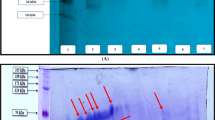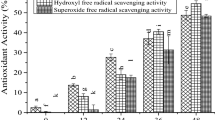Abstract
Lactobacillus rhamnosus C6 was used for milk fermentation with the aim of synthesizing antimicrobial and antioxidant peptides rich preparations. The proteolysis was checked for an incubation period of 72 h to check the extent of both bioactivities in fermentate. The 36 h incubated fermentate showed higher inhibition zone diameter against E. coli ATCC 25922 as well as antioxidant activity. Ultrafiltrate was further purified by solid phase extraction and then subjected to reverse phase chromatography. Among 12 fractions collected, higher activity containing fractions were sequenced through LC–MS and characterized. Total 49 peptide sequences identified including 13 novel sequences rich in proline with helix forming ability. Higher antimicrobial activity containing fractions have potent previously reported Casicidin-17 peptides along with a series of proline rich peptides. Antioxidant rich peptides profile contains 21 peptide of smaller sequence of mainly 9–12 amino acids with lower molecular weight. This study demonstrates the capacity of L. rhamnosus C6 to release antioxidative and antimicrobial peptide by proteolysis of milk proteins through peptide profiling and characterization.






Similar content being viewed by others
References
Abubakar A, Saito T, Kitazawa H, Kawai Y, Itoh T (1998) Structural analysis of new antihypertensive peptides derived from cheese whey protein by proteinase k digestion. J Dairy Sci 81:3131–3138
Ageyi D, Potumarthi R, Danquah M (2012) Optimization of batch culture conditions for cell-envelope-associated proteinase production from Lactobacillus delbrueckii subsp. lactisatcc® 7830™. Appl Biochem Biotechnol 168:1035–1050
Benkerroum N (2010) Review: antimicrobial peptides generated from milk proteins: a survey and prospects for application in the food industry. Int J Dairy Technol 63:320–338
Bikshapathy E, Sitaram N, Nagaraj R(1999) Effect of introducing p-fluorophenylalanine and multiple tryptophan residues in a 13-residue antibacterial peptide. Protein Pept Lett 6:67–71
Birkemo G, Sullivan O, Ross R, Hill C (2009) Antimicrobial activity of two peptides casecidin 15 and 17, found naturally in bovine colostrums. J Appl Microbiol 106:233–240
Chang O, Seol K, Jeong S, Oh M, Park B, Perrin C, Ham J (2013) Casein hydrolysis by Bifidobacterium longum KACC91563 and antioxidative activities of peptides derived therefrom. J Dairy Sci 61:7294–7300
Chi CF, Huan FY, Wang B,Li ZR, Luo HY (2015) Influence of amino acid compositions and peptide profiles on antioxidant capacities of two protein hydrolysates from Skipjack tuna (Katsuwonus pelamis) dark muscle. Mar Drugs 13:2580–2601. doi:10.3390/md13052580
Church F, Swaisgood H, Porter D, Tignani, G. Ca (1983) Spectrophotometric assay using o-phthaldialdehyde for determination of proteolysis in milk and isolated milk proteins. J Dairy Sci 66:1219–1227
Conway V, Gauthier SF, Pouliot Y (2013) Antioxidant activities of buttermilk proteins, whey proteins, and their enzymatic hydrolysates. J Agric Food Chem 61:364–372
Dennison RS, Howe J, Morton HG, Brandenburg K, Harris F, Phoenix DA (2006) Interactions of an anionic antimicrobial peptide with Staphylococcus aureus membranes. Biochem Biophys Res Commun 347:1006–1010
Donkor O, Henriksson A, Vasiljevic T, Shah N (2007) Proteolytic activity of dairy lactic acid bacteria and probiotics as determinant of growth and in vitro angiotensin-converting enzyme inhibitory activity in fermented milk. Le Lait 87:21–38
Dziuba B, Dziuba M (2014) New milk protein-derived peptides with potential antimicrobial activity: an approach based on bioinformatic studies. Int J Mol Sci 15(8):14531–14545. doi:10.3390/ijms150814531
Farvin KH, Caroline P, Nielsen N, Jacobsen C (2010) Antioxidant activity of yoghurt peptides: part 1-in vitro assays and evaluation in ω-3 enriched milk. Food Chem 123:1081–1089
Hancock REW, Rozek A (2002) Role of membranes in the activities of antimicrobial cationic peptides. FEMS Microbiol Lett 206(2):143–149. doi:10.1016/S03781097(01)00480-3
Hayes M, Ross RP, Fitzgerald GF, Stanton C, Hill C (2006) Casein-derived antimicrobial peptides generated by Lactobacillus acidophilus DPC6026. Appl Environ Microbiol 72:2260–2264
Hernandez-Ledesma B, Davalos A, Bartolome B, Amigo L (2005) Preparation of antioxidative enzymatic hydrolysates from α-lactalbumin and β-lactoglobulin. Identification of active peptides by HPLC-MS/MS. J Agric Food Chem 53:588–593
Himaya SW, Ryu B, Ngo DH, Kim SK (2012) Peptide isolated from Japanese flounder skin gelatin protects against cellular oxidative damage. J Agric Food Chem 60:9112–9119
Lopez-Exposito I, Gomez-Ruiz J, Quiros A, Amigo L, Recio I (2006). Identification of antibacterial peptides from ovine αS2-casein. Int Dairy J 16:1072–1080
Lopez-Exposito I, Quiros A, Amigo L, Recio I (2007) Casein hydrolysates as a source of antimicrobial, antioxidative and antihypertensive peptides. Le Lait 87:241–249
Lopez-Exposito I, Amigo L, Recio I (2008) Identification of initial binding sites of αS2 casein f(183–207) and effect on bacterial cell membranes and cell morphology. Biochem Biophys Acta Biomembr 1778:2444–2449
McCann KB, Shiell BJ, Michalski WP, Lee A, Wan J, Roginski H, Coventry MJ (2006) Isolation and characterisation of a novel antibacterial peptide from bovine αS1-casein. Int Dairy J 16(4):316–323
Minervini F, Algaron F, Rizzello CG, Fox PF, Monnet V, Gobbetti M (2003) Angiotensin-I-converting-enzyme inhibitory and antibacterial peptides from Lactobacillus helveticus PR4 proteinase-hydrolyzed caseins of milk from six species. Appl Environ Microbiol 69:5297–5305
Mohanty D, Rajshree J, Choudhary P, Pallnaik R, Mohapatra S, Saini MR (2016) Milk derived antimicrobial bioactive peptides: a review. Int J Food Prop 19(4):837–846.
Ordonez AA, Begley M, Clifford T, Deasy T, Considine K, Hill C (2013) Structure activity relationship of synthetic variants of the milk derived antimicrobial peptide αS2-Casein f(183–207). Appl Environ Microbiol 79:5179
Pan D, Guo Y (2010) Optimization of sour milk fermentation for the production of ACE-inhibitory peptides and purification of a novel peptide from whey protein hydrolysates. Int Dairy J 20:472–479
Park SC, Kim MH, Hossain MA, Shin SY, Hahm K (2008) Amphipathic α–helical peptides, HP (2–20) and its analogues derived from Helicobacter pylori: pore formation mechanism in various lipid compositions. Biochim Biophys Acta 1778:229–241
Power JP, Hancock RE (2003) The relationship between peptide structure and antibacterial activity. Peptides 24(11):1681–1691
Re R, Pellegrani N, Pannula A, Yang M, Rice-Evans C (1999) Antioxidant activity applying an improved ABTS radical cation decolouration assay. Free Radic Biol Med 26:1231–1237
Rizzello CG, Losito I, Gobbetti M, Carbonara TM, De Bari D, Zambonin PG (2005) Antibacterial activities of peptides from the water-soluble extracts of italian cheese varieties. J Dairy Sci 88:2348–2360
Shah BNP, Vasiljevic T, McKechnie S, Donkor ON (2016) Antibacterial and antiproliferative peptides in synbiotic yogurt—release and stability during refrigerated storage. J. Dairy Sci 99(6):4233–4242. doi:10.3168/jds.2015-10499
Tzvetkova I, Galarrondo M, Danova S, Ivanova I, Chobert J, Haert T (2006) Hydrolysis of major dairy proteins by lactic acid bacteria from bulgarian yogurts. J Food Biochem 31:680–702
Yeaman MR, Yount NY (2003) Mechanisms of antimicrobial peptide action and resistance. Pharmacol Rev 55(1):27–55. doi:10.1124/pr.55.1.2
Acknowledgements
The research work was supported by National Dairy Research Institute, Karnal.
Author information
Authors and Affiliations
Corresponding author
Ethics declarations
Conflict of interest
The authors declare that they have no conflict of interest.
Ethical approval
This article does not contain any studies with human participants or animals performed by any of the authors.
Rights and permissions
About this article
Cite this article
Rana, S., Bajaj, R. & Mann, B. Characterization of Antimicrobial and Antioxidative Peptides Synthesized by L. rhamnosus C6 Fermentation of Milk. Int J Pept Res Ther 24, 309–321 (2018). https://doi.org/10.1007/s10989-017-9616-2
Accepted:
Published:
Issue Date:
DOI: https://doi.org/10.1007/s10989-017-9616-2




